
Images of Statue of Liberty courtesy of Mirio-jk
 Copyright © Michael Richmond.
This work is licensed under a Creative Commons License.
Copyright © Michael Richmond.
This work is licensed under a Creative Commons License.
Contents
Although individual lifeforms are much, much, much, MUCH too small to be resolved with any current telescopes -- heck, we can't even resolve any PLANETS around other stars -- their cumulative effects on their environment, over long periods of time, might, under some circumstances, rise to a significant level. The key is that planets, or animals, or strange creatures, can modify the composition of their planet's atmosphere in ways that are hard to explain. Any instances of atmospheric disequilibrium we detect may be evidence for some sort of life.
What does that mean, "atmospheric disequilibrium?" Let's use an analogy: the Statue of Liberty. This giant sculpture in New York Harbor was coated with an outer layer of copper, which was originally a shiny reddish-brown color, as seen in the left panel below. But, over time, the statue has gradually become a blueish-green color (as seen in the right-hand panel).

Images of Statue of Liberty courtesy of
Mirio-jk
Q: Why didn't the Statue of Liberty remain shiny and reddish-brown?
The answer, of course, is that the interaction of the outermost copper layer with oxygen in the Earth's atmosphere caused a series of chemical changes. I'm not chemist, so let me turn to the kind folks at the Australian Academy of Science to explain:
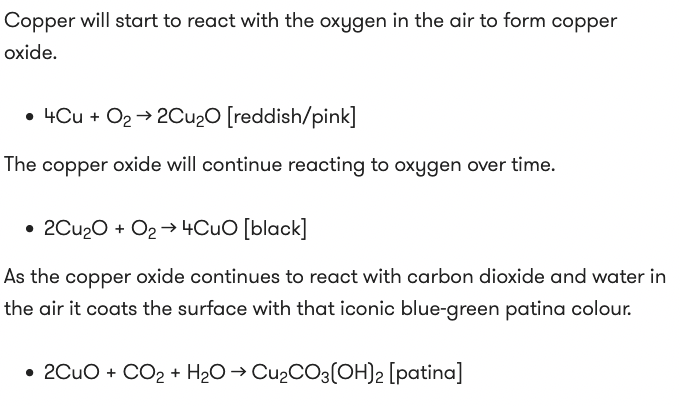
Explanation courtesy of
the Australian Academy of Science.
In other words, the initial outer coating of copper eventually comes to a chemical equilibrium with the surrounding atmosphere. Result: a blueish-green color.
But sometimes, an equilibrium is disturbed. This copper statue of journalist Victor Noir, made soon after his death in 1870, is covered with a blueish patina, as one would expect ...

Image courtesy of
Wikipedia
... except for his nose, lips, and chin, which look shiny and new.

Image courtesy of
Wikipedia and Serein
Q: Why are these sections of the statue not covered with patina? Q: What can we conclude about the environment around this statue?
The reason why his nose and lips are shiny is that visitors to the grave keep rubbing or kissing them (apparently, there's some local tradition that doing so will bring good luck). As a result, any patina that starts to form is rubbed off from the surface.
What we can conclude is that some factor in the local environment is preventing the statue from reaching equilibrium. In this case, the "factor" is humans who rub the statue.
Let's return to exoplanets. Suppose that we can determine the chemical composition of some exoplanet's atmosphere, as well as the approximate physical characteristics (temperature, pressure, etc.) of the gas. If we see a mixture of gases which are in chemical equilibrium under the local conditions, then we conclude ... nothing interesting is happening.
But if we find some species which would NOT be in equilibrium under the local conditions -- in other words, if we find evidence for an atmospheric disequilibrium -- then SOMETHING must be consistently producing that species. In some cases, that SOMETHING might be a form of life.
For example, consider molecular oxygen, O2. Under Earth conditions, this is a very chemically active molecule: it will react with many different substances, such as bronze, or copper, or iron, to form compounds called oxides. Once they form, those oxides require quite a bit of energy to break. The result is that, over geologically or astronomically short periods of time (a few million years, perhaps), all the molecular oxygen in the Earth's atmosphere would eventually disappear. Well, very small amounts might be created by occasional energetic events, but the equilibrium abundance of molecular oxygen should only be a tiny fraction of a percent.
Q: So, why is the Earth's atmosphere nearly 21 percent O2?
Right. Because various forms of life produce molecular oxygen as a result of photosynthesis.
In short, a high concentration of molecular oxygen in a planet's atmosphere is a potential biosignature.
If we concentrate on forms of life with which we are familiar -- those found on Earth -- then several atmospheric components stand out as possible biosignatures:
Let's look at each one briefly.
Plants produce O2 as product of photosynthesis

Does molecular oxygen produce any absorption or emission lines that might stand out in spectroscopic studies of exoplanets? Unfortunately, the answer is, largely, no.
One of the strongest features appears as an absorption band at 0.76 microns. Since it lies in the optical, rather than in the IR, this line requires reflectance measurements by a space telescope optimized for visible light. In addition, the line is relatively narrow. Although future space telescopes might be designed to detect it, the current generation cannot.
While O2 does have a few features in the near-IR, they are weak and narrow. There's very little hope for detecting features of oxygen directly ...
... but that doesn't mean we have to give up on oxygen entirely. If a planet's atmosphere has a high concentration of O2, and if that atmosphere is also subject to events which involve high-energy photons -- such as ultraviolet light from the host star, or lightning flashes -- then the ordinary molecular oxygen can be converted into a different form: ozone.

The "A" in these equations stands for any other atom or molecule, such as N2 or O2, which takes part in the reaction to conserve energy and momentum.
Unlike O2, ozone does have strong features in the near-IR, making it a much better target for our current set of telescopes. Note the values on the vertical scale, describing the strength of the feature, for both molecules. The most prominent ozone line appears around 9.6 microns.

Image taken from Figure 4 of
Schwieterman Leung,
Reviews in Mineralogy and Geochemistry, 91 (2024)
Nitrous oxide is produced by microbes in a cycle which "fixes" nitrogen, converting atmospheric N2 into a form that can be used by plants and animals. The details are rather complex ...

Image courtesy of
Aryal, B., et al., Environmental Pollution, 314 (2022)
... so let's just concentrate on the result. Even a small amount of this gas can produce strong features in a planet's spectrum. On the Earth, for example, the concentration of N2O is only about 330 ppb (parts per billion), yet it has a significant effect on global temperatures.
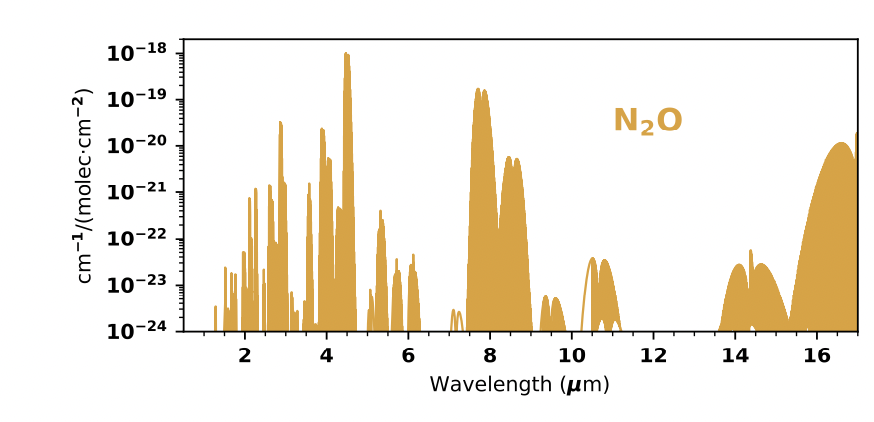
Image taken from Figure 4 of
Schwieterman Leung,
Reviews in Mineralogy and Geochemistry, 91 (2024)
Two of the strongest features appear close together in the mid-IR, around 7.8 and 8.5 microns. By a coincidence, the first of these is very close to the wavelength of another possible biosignature, which we will consider next; that makes this a particularly attractive wavelength for exoplanetary life searches.
The last molecule we'll consider as a signpost for life is methane. It can be produced directly from atmospheric carbon dioxide and molecular hydrogen
or through the dissociation of acetic acid.

Like N2O, methane has a strong absorption cross-section, so that small concentrations can produce strong lines. The Earth's atmosphere contains only about 2 ppm (parts per million) of methane, but it is one of the most important greenhouse gases. As mentioned earlier, one of methane's strongest features in the IR is a wide band centered at 7.7 microns. This overlaps one of the strong lines of nitrous oxide.
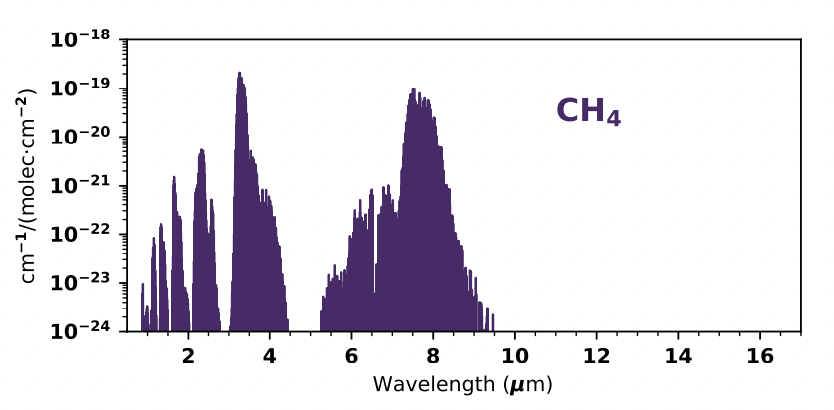
Image taken from Figure 4 of
Schwieterman Leung,
Reviews in Mineralogy and Geochemistry, 91 (2024)
It appears that we have three reasonable biomarkers in the near-infrared spectral region: ozone, nitrous oxide, and methane. Just how prominent might they be, compared to all the "abiological" features such as CO2, H2O, etc.? Well, we can use the Earth as an example. The figure below shows the Earth's transmission spectrum over the range from 2 to 15 microns.

Spectrum courtesy of
Lustig-Yeager et al., Planet. Sci. 4, 170 (2023)
Q: Which of the possible biosignatures appear most obvious?
What are the most important wavelengths?
When astronomers design future instruments for the purpose of searching for signs of extraterrestrial life, they should keep these particular features in mind.
Just how well can we observe these potential biosignatures at present? Our most powerful tool at the moment is the James Webb Space Telescope, and the instrument most well suited to this purpose is its Near Infrared Spectrograph (NIRSpec). The detectors of NIRSpec are made of mercury-cadmium-telluride (HgCdTe), which -- alas -- is sensitive to photons with wavelengths shorter than 5.5 microns:
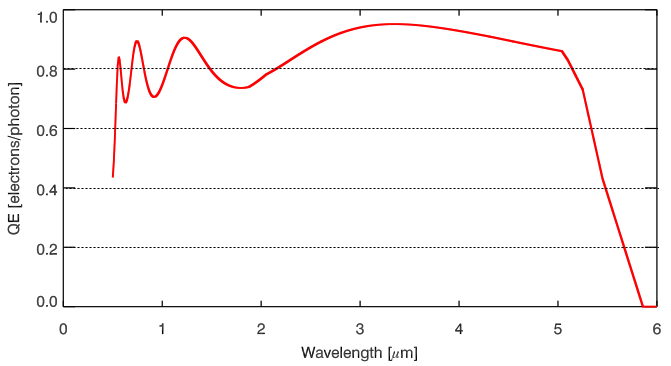
Figure 5 taken from
NIRSpec Performance,
thanks to STScI
That means that the great majority of the current transmission spectroscopy of exoplanet atmospheres look something like this (an example from observations of the hot Jupiter WASP-39b):
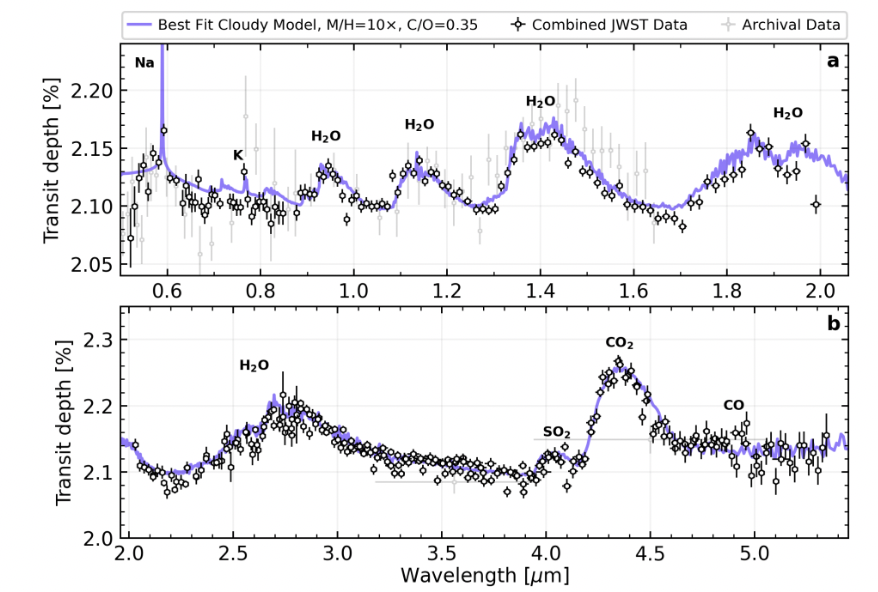
Figure 3 taken from
Carter, A. L., et al., Nature Astronomy, 8, 1008 (2024)
Q: Can we see any potential biosignatures in this spectrum?
There is one instrument on JWST which can perform spectroscopy at longer infrared wavelengths: MIRI. It can perform spectroscopy with a resolution of R = 1500-3000 from wavelengths of 5 to 27 microns, because its detectors are based on arsenic-doped silicon (Si:As) rather than HgTeCd. Due to some systematic effects in the instrument, and the complexity of its data reduction, it has not been used very much for spectroscopy of exoplanets as of 2024. However, some astronomers are advocating for its use in exoplanet studies.
Before the age of spacecraft, astronomers on the ground studied Mars avidly. As the body in our Solar System with properties closest to those of the Earth, it seemed the best place to look for life beyond our own planet. Ground-based telescopes struggle to create clear images of Mars due to the effects of the Earth's atmosphere, but one can, at times, discern quite a few surface features.

Images taken from
The Sand Ships of Mars
by Jeffrey Beish (2020)
Some astronomers noticed changes to these features over time. Percival Lowell noticed that some of the features grew stronger and weaker in sync with the changing seasons on Mars. His book Mars and its Canals shows maps of the planet's surface based on his own observations from Lowell Observatory in Arizona. Below are his sketches of the region around Mare Erythraeum on the Martian equivalents of Dec 30 (left) and Feb 1 (right).
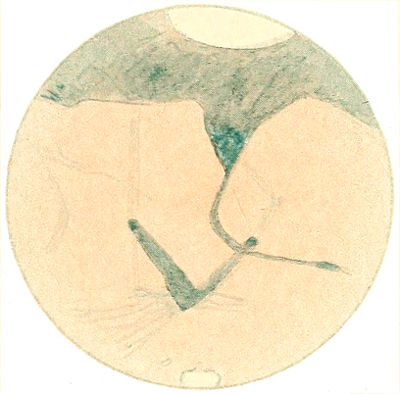
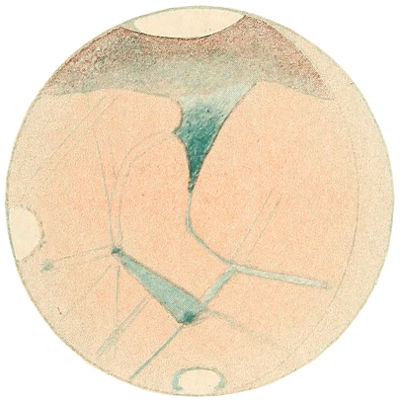
Sketches taken from
Mars and its Canals
by Percival Lowell (1906)
Note the change in color, as well as the strengthening of some of the dark features. Lowell ascribed these changes to the growth of vegetation around waterways which flooded every spring, as the polar caps melted.
(It turns out these changes are due to the transport of dust by windstorms -- but, to be fair, those storms follow the Martian seasons, just as Lowell had concluded).
Could we detect large-scale changes in surface feature of an exoplanet, even if we could not resolve its disk? For example, if a large fraction of the visible surface of a planet changed from "covered in dirt" to "covered in grass", would it be possible to detect the transformation?
Scientists who perform remote sensing of the Earth -- those who point their satellite's telescopes DOWN instead of UP -- have found that there is a strong spectral signature of vegetation. When light strikes leaves, or other structures filled with chlorophyll, the short-wavelength photons are absorbed with high efficiency; it is from those photons that plants derive their energy and convert it into chemical form. Photons with long wavelengths, on the other hand, tend to be reflected. The result is that the reflectance spectrum of leaves shows a strong feature: the Vegetation Red Edge (VRE):
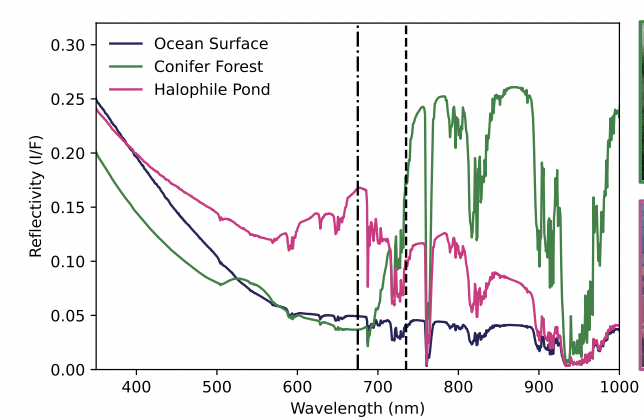
Image taken from Figure 13 of
Schwieterman Leung,
Reviews in Mineralogy and Geochemistry, 91 (2024)
In theory, one might even use sufficiently detailed measurements to determine the health of extraterrestrial plants.
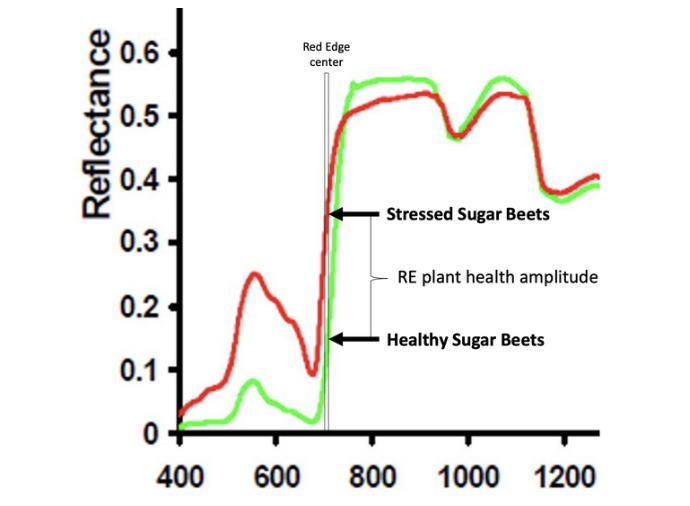
Image courtesy of
Red Edge detects vegetative stress earlier in plant growth cycle
by John Olinger
One big advantage of this indicator over the spectral features of various gases is that it does not require high spectral resolution. In fact, the feature is so broad that one might detect it with broadband photometry: measuring the brightness of an exoplanet's light through several filters and computing the differences, just as we determine a star's (B-V) color. Photometry is much more sensitive than spectroscopy, simply because it doesn't divide the photons into many small bins before recording them.
Of course, as we have seen in a previous lecture, the REFLECTED light from exoplanets is very, very, very hard to detect in the first place. In order for human astronomers to see a change in the color of an entire planet, several conditions would have to be met:
This type of biosignature seems unlikely to be relevant in the near future, but might become a good approach with more powerful equipment in the future.
If life develops into a technological civizilation on some exoplanet, it might employ radio waves for communication, just as humans have done. It seems logical, therefore, to use our astronomical radio telescopes to look for radio signals from other civilizations; and, indeed, radio astronomers have a long history of doing so, starting with Project Ozma in 1960 and continuing through the current day.

Photo of the Howard E. Tatel Radio Telescope at Green Bank
Observatory, used for Project Ozma,
courtesy of
Wikimedia and Z22
As the The Hitchhiker's Guide to the Galaxy states, Space is big. Really big. We can see billions of galaxies, each of which contains billions of stars -- where should we look for such radio signals? One approach which addresses WHERE to look is to choose particular systems which show some promise:
Recently, a group of astronomers found another way to narrow down the myriad possibilities: choose exactly WHEN to look. The point is that some radio transmitters radiate a very tightly directed signal. If the beam of such a transmitter is pointed away from the Earth, it's unlikely that we could detect it; but if that transmitter happens to be pointing right at the Earth, either by design or by accident, then our chances of detecting it increase drastically.
For example, suppose that in some other stellar system, two planets orbit the central star. On each planet live some creatures, and they communicate with each other via radio waves. In order to save power, their radio transmitters emit a narrow beam.
Now, most of the time, if planet A sends a message directly towards planet B, the radio waves which go past B will fly away into space in some arbitrary direction, far from the direction of the Earth.
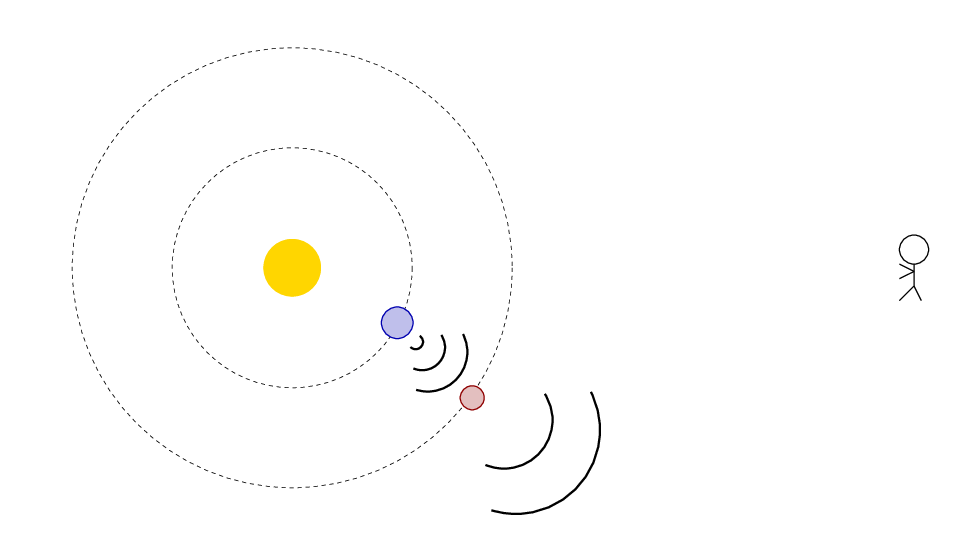
But, every now and then, when the line between planet A and planet B just happens to align with the Earth, radio waves sent from A which miss B will head directly toward the Earth.
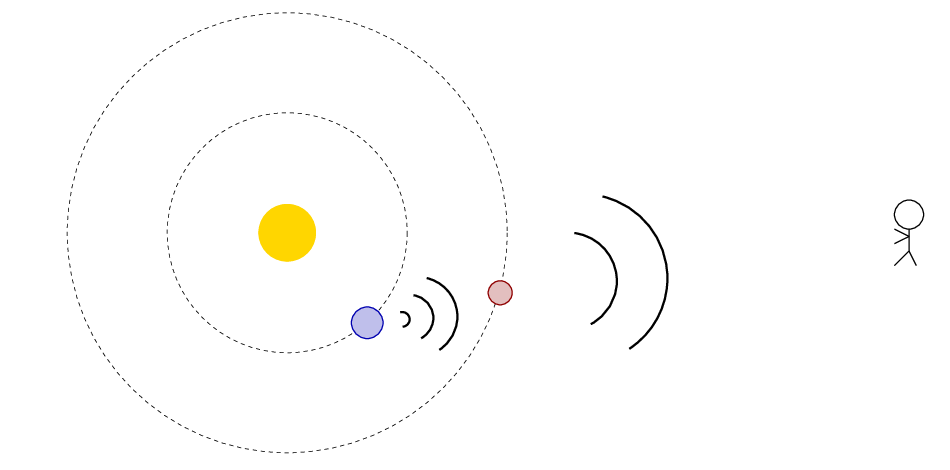
The authors of a recent paper,
figured out a method which would allow them to choose times WHEN to look. Their target was the system TRAPPIST-1, in which seven terrestrial planets orbit an M dwarf star. Several of the planets lie within the system's habitable zone, and the system is only about 12 parsecs from the Sun, so it's a very tempting place to look.
The new feature of this particular search was picking times to observe the system: since astronomers know the properties of the orbits of all seven planets, thanks to their transits, we can compute the location of each planet at any given time. As the authors write in their abstract,
Planet-planet occultations (PPOs) occur when one exoplanet occults another exoplanet in the same system as seen from the Earth's vantage point. PPOs may provide a unique opportunity to observe radio "spillover" from extraterrestrial in- telligences' (ETIs) radio transmissions or radar being transmitted from the further exoplanet towards the nearer one for the purposes of communication or scientific exploration. Planetary systems with many tightly packed, low-inclination planets, such as TRAPPIST-1, are predicted to have frequent PPOs. Here, the narrowband technosignature search code turboSETI was used in combination with the newly developed NbeamAnalysis filtering pipeline to analyze 28 hours of beamformed data taken with the Allen Telescope Array (ATA) during late October and early November 2022, from 0.9-9.3 GHz, targeting TRAPPIST-1. During this observing window, 7 possible PPO events were predicted using the NbodyGradient code.
Click on the figure below to watch an animation.
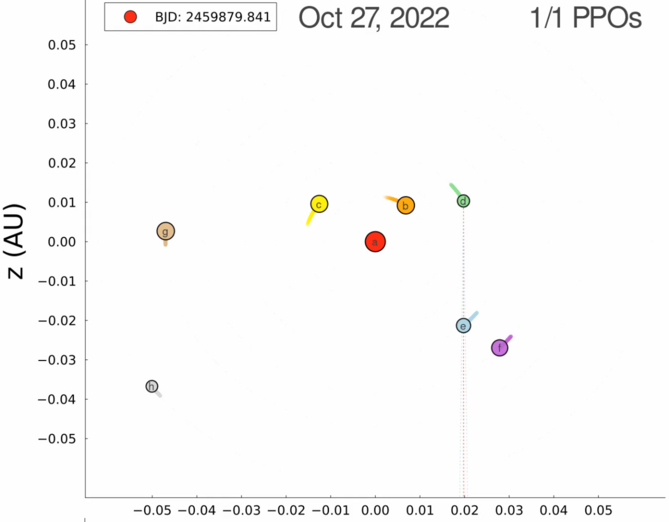
Movie and Figure 10 taken from
Tusay et al., arXiv 2409.08313 (2024)
The team built a software pipeline to analyze the radio data, specially designed to reject Radio Frequency Interference (RFI) and to identify promising signals. As a test of their software, they pointed their telescope at the planet Mars at times when the believed that some of our space probes would be transmitting data back to Earth. Their pipeline identified a number of signals which were, in fact, due to the spacecraft. The example below is a transmission from the Mars Odyssey orbiter.

One panel from Figure 7, taken from
Tusay et al., arXiv 2409.08313 (2024)
Sifting through the 28 hours of radio measurements from the TRAPPIST-1 observations, the software selected 11,127 candidate signals, of which 1,627 occured during periods of PPO. There was no significant increase in the number of candidates during periods of PPO. After examining all the candidates carefully, the team concluded that none were likely to be due to transmissions from devices in the TRAPPIST-1 system.
Alas.
Now, a question one ought to ask about any search for radio signals is "Was our equipment sensitive enough to detect the expected radio waves?" Even though TRAPPIST-1 is very close to the solar system (just 12 pc away), the amplitude of "ordinary" radio transmissions at such a great distance is very small. In their conclusions, Tusay et al. note (with emphasis added by me)
The minimum detectable transmitter power by the ATA during these observations, listed in Table 1, show that much greater sensitivity is needed to detect transmissions with power on the order of the DSN, which typically operates at tens of kiloWatts of directed transmission, and ~10 GW EIRP(Derrick & Isaacson 2023b). It is technically feasible that an Arecibo-like transmitter-operating at 20 TW EIRP-would be detectible by the ATA at low to moderate drift rates, but such powerful transmitters are generally seen as overkill, especially in the compact TRAPPIST-1 system, and not regularly used as part of the DSN for interplanetary communication. However, future observatories, such as the Square Kilometer Array may provide the sensitivity required to detect levels of leaked emission comparable to the DSN (Braun et al. 2019). Detection of leaked radio emission from nearby planetary systems may be on the horizon.
Clearly, we have some way to go in our search for radio technosignatures.
A Dyson sphere is a structure which allows a very advanced civilization to capture a large fraction of the TOTAL energy output of a star. Imagine large portions of a sphere surrounding the star, coated on the inside with solar cells or some similar technology.
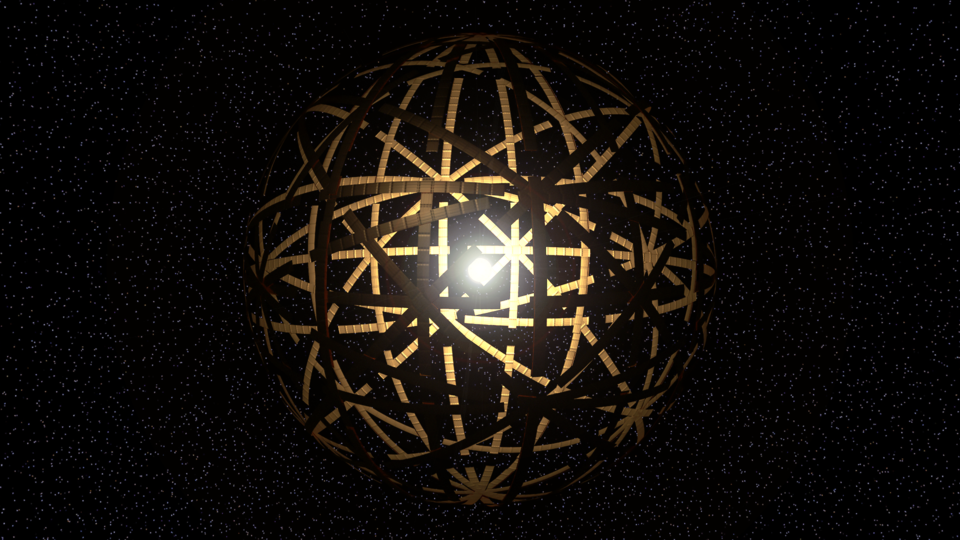
Picture by Kevin Gill, courtesy of
Wikimedia
Pretty cool, right?
How could we detect such structures? If we were lucky, one might be close enough to the Solar System that our best telescopes could show us the structure directly ... but that doesn't seem to be the case.
Rats. Is there any other way to detect a Dyson sphere?
Yes! Look for its spectral signature.
Let me explain. If we measure the spectrum of a typical star -- the power it emits as a function of wavelength -- we see something like this:

That shape -- a sharp rise at short wavelengths, followed by a gradual decline at longer wavelengths -- is characteristic of thermal blackbody radition. A solid, or very dense gas, will emit this sort of radiation based upon its temperature. Typical stars emit most of their energy in the optical, very much like blackbodies with temperatures of thousands of degrees Kelvin,
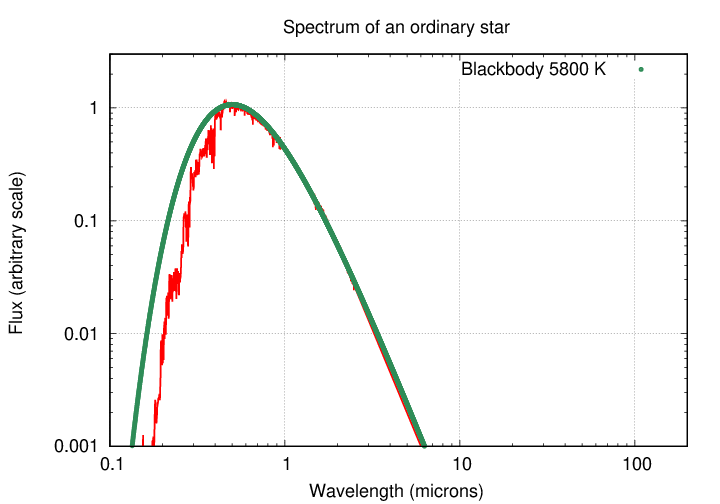
Much cooler blackbodies have a similar spectral shape, but its peak is shifted to longer wavelengths. An object with temperature similar to the Earth will emit most of its energy around 10 microns.
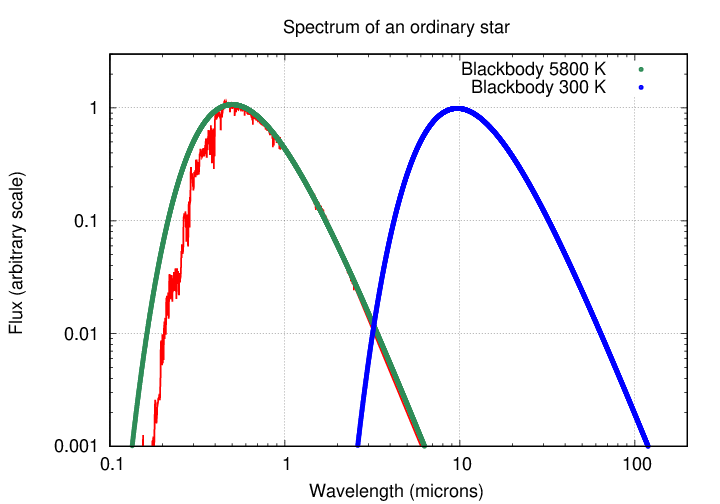
Now, look at this particular Dyson sphere again: it has plenty of holes, so that some of the starlight flies out into space directly. But it also absorbs some of the star's light, and those portions of the structure will heat up. If the structure has a radius of roughly 1 AU (the distance from the Sun to the Earth), then it will have a temperature similar to the Earth's temperature; and that means it will emit lots of infrared radiation.

Picture by Kevin Gill, courtesy of
Wikimedia
The sum of the star's light and the sphere's light would have a spectrum something like this:
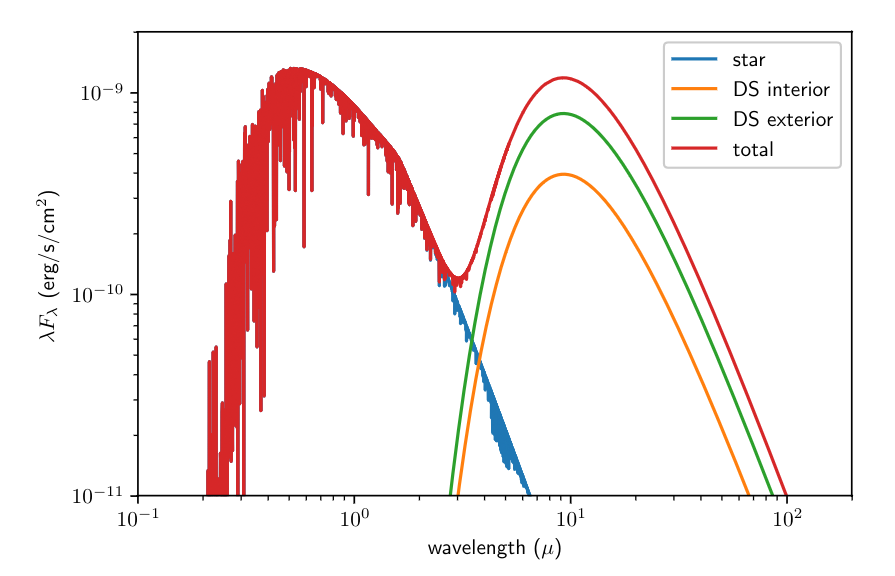
Figure 2 taken from
Wright, J. T., Serbian Astronomical Journal, 200, 1 (2020)
So, one way to look for these giant extraterrestrial structures is to examine the spectra of stars: lots and lots of stars. If we find stars with spectra showing a strong infrared excess, then we might conclude that a Dyson sphere surrounds the star.
Q: Is there any other type of object which might create
an infrared excess around a star?
Indeed there is. If a star is surrounded by a disk of gas and dust, that material will also be heated by the star and so emit infrared radiation. Moreover, disks with a "hole" in the inner regions will produce a spectrum with a gap between the star's optical light and infrared emission from the disk -- which could look very much like a Dyson sphere.
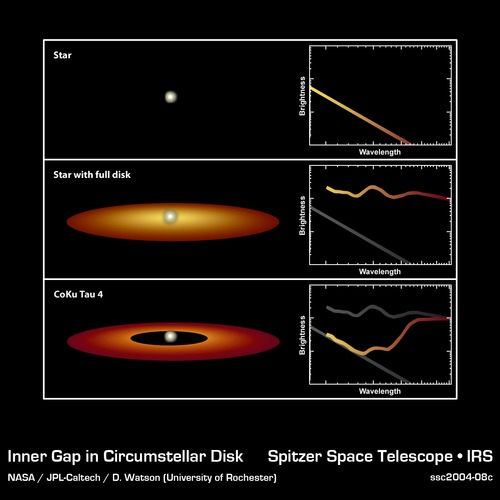
Image courtesy of
Credit: NASA/JPL-Caltech/D. Watson (University of Rochester)
And since all stars form from clouds of gas, and are surrounded by disks in the final stages of their early evolution, we expect to find -- and DO find -- many, many circumstellar disks around young stars. Distinguishing between ordinary circumstellar disks and giant structures built by alien civilizations could be quite difficult.
One recent search for Dyson spheres is
The authors chose a set of stars with well-measured properties in the optical and near-infrared, starting with a total of about 5 million objects. They use measurements from optical telescopes and 2MASS (out to 2 microns) to fits the stellar spectrum, and then predict how bright the spectrum ought to be at longer wavelengths of 3.4 and 4.6 microns. The great majority of stars match their predictions. A tiny fraction, however, emit more radiation at these mid-infrared wavelengths than predicted, showing an infrared excess.
Here's an example from the paper:
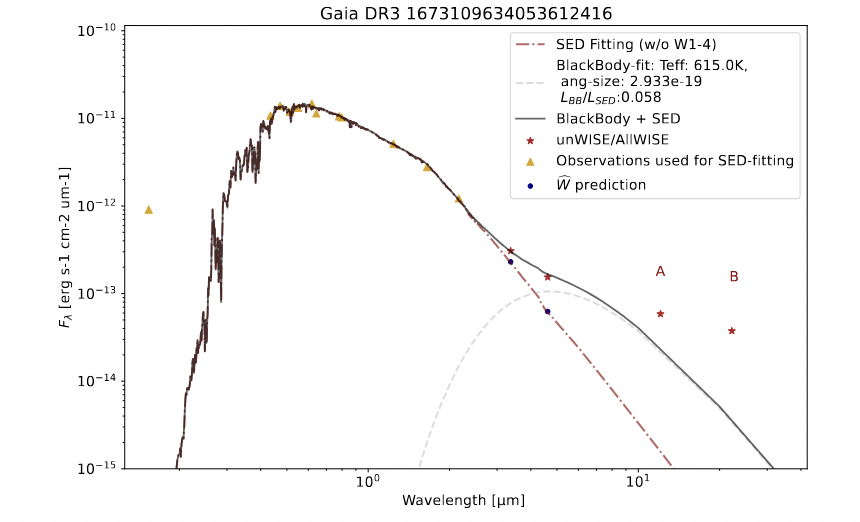
Figure 11 from
Contardo and Hogg, AJ 168 (2024)
Just how many sources from the original 5 million show strong evidence for anomalous infrared excess? Not many: Contardo and Hogg end up with just 53 candidates!
As a very clever check on their method, the authors apply the same rules to look for objects which have anomalous infrared DEFICITS, rather than excesses. There's no good physical reason to expect any such objects to exist, so if their method found any, it might indicate some problem with their procedures, or with the data they are using. But not a single such infrared-faint object passed through their selection criteria, which suggests that their methods (and data) are sound.
A second, very similar, search, was carried out independently by a different set of researchers:
This study sifted through a different initial set of 320,000 stars, generating a final list of just 7 (seven) candidates. (I checked, but none of these match candidates from the Contardo and Hogg paper.)
Both papers urge other astronomers to collect more information on their candidates. Will any of them turn out to be titanic structures built by alien civilizations? Only time will tell ...
 Copyright © Michael Richmond.
This work is licensed under a Creative Commons License.
Copyright © Michael Richmond.
This work is licensed under a Creative Commons License.